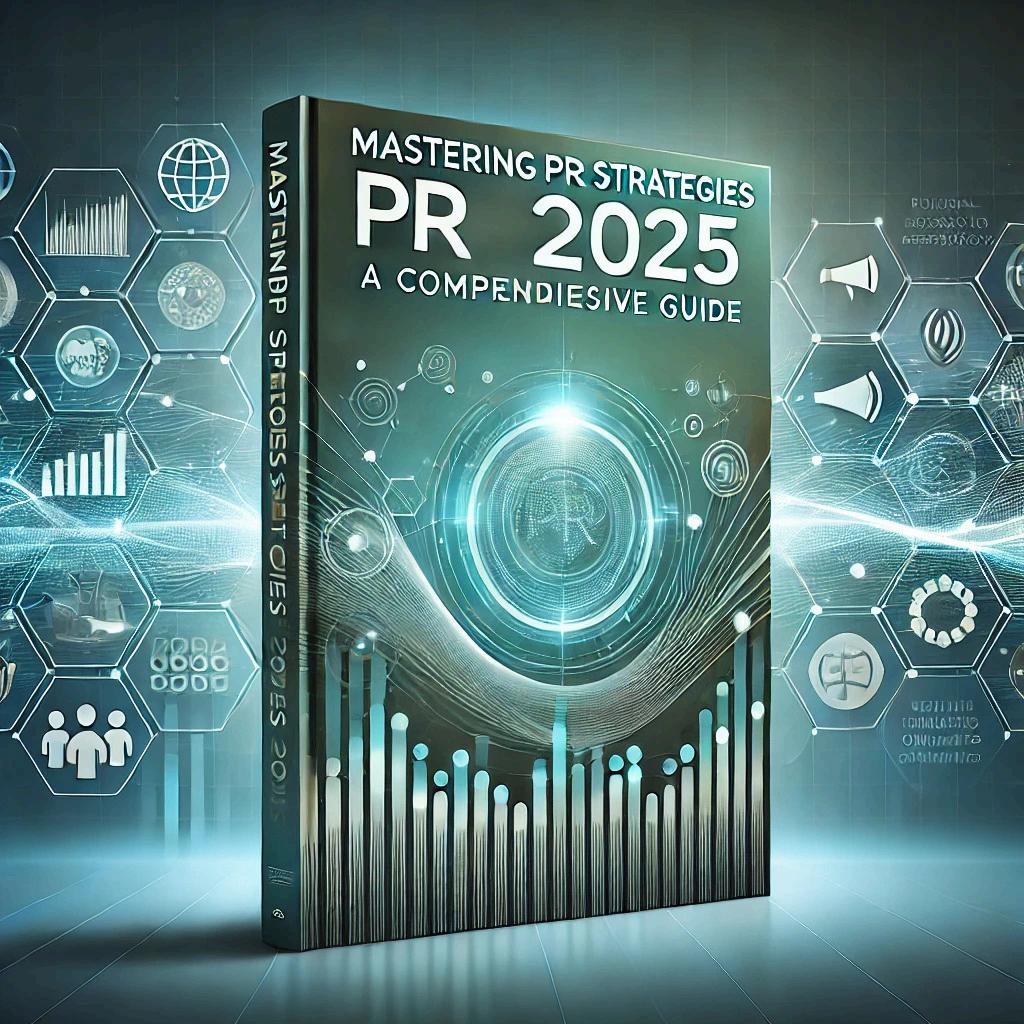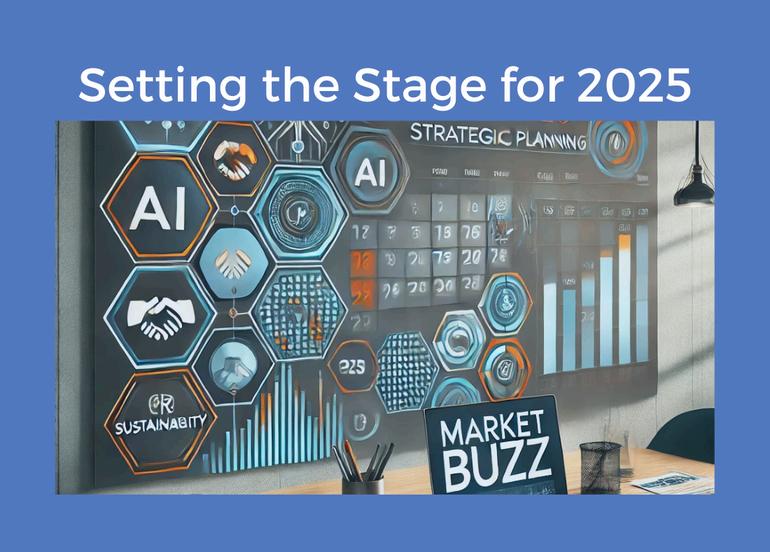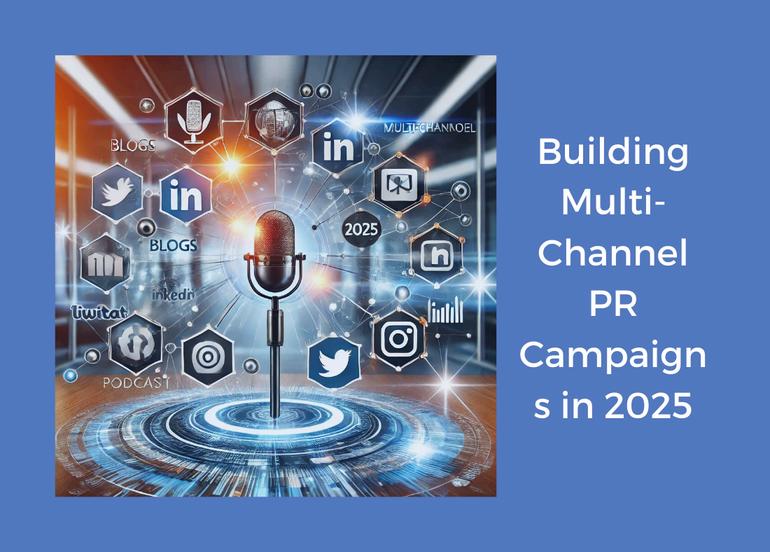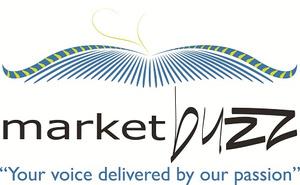

TABLE OF CONTENTS
Setting
SETTING THE STAGE FOR 2025

As we approach 2025, businesses often find themselves juggling multiple priorities. Yet, one crucial task that should never fall to the bottom of the to-do list is planning your PR strategy for the upcoming year. A well-crafted PR strategy not only helps you stay ahead of the curve but also positions your brand as a thought leader in your industry.
In 2025, public relations will continue to evolve with new trends and challenges.
Why Planning Early Matters
PR is more than just a series of campaigns it’s a sustained effort to build relationships, establish trust, and manage your brand’s reputation. Waiting until January to plan could mean missed opportunities to connect with your audience. Planning ahead allows you to:
Identify key trends and align your strategy accordingly. Set realistic goals and allocate resources effectively. Be proactive rather than reactive in your communication efforts.
Every year brings fresh trends that influence how brands interact with their stakeholders. While we’ll explore these in-depth in the next blog post, here are some key areas to consider:
1 AI-Powered PR: Artificial Intelligence (AI) is revolutionising PR practices, from media monitoring to content creation. AI-powered tools are leading the way in altering social media monitoring, media list targeting, and even automating content generation Staying ahead means incorporating AI into your PR toolbox
2 Sustainability and ESG Communication Stakeholders increasingly value brands with strong commitments to Environmental, Social, and Governance (ESG) principles. In 2025, PR teams will focus on representing diverse voices and promoting inclusive values
3 Authenticity in Messaging Consumers demand transparency and authenticity from brands. PR professionals must ensure messaging reflects genuine values and intentions, avoiding corporate jargon and insincerity.
4 Omnichannel Storytelling Effective PR strategies require consistent storytelling across multiple platforms, including blogs, social media, and traditional media This ensures a cohesive brand narrative and maximises audience engagement.
These trends underscore the importance of adaptability and innovation in PR strategies To align your approach with these emerging trends, consider incorporating feedback and stakeholder insights.
HARNESSING TRENDS
In 2025, the landscape of public relations continues to evolve. Staying ahead of the curve requires businesses to embrace emerging trends, rethink traditional strategies, and align their PR efforts with the expectations of modern stakeholders.

AI-Powered PR: Automating Intelligence, Amplifying Impact
Artificial Intelligence (AI) is transforming how PR professionals work. From media monitoring to predictive analytics and content generation, AI-powered tools save time and enhance accuracy
Explore tools like Muck Rack, Prowly, or HubSpot for AI-driven media outreach and analysis.
Use AI to personalise pitches and tailor content for specific audiences
Sustainability and ESG Communication: The Need for Purpose-Driven Messaging
In 2025, businesses must communicate their commitment to Environmental, Social, and Governance (ESG) principles transparently Consumers increasingly expect brands to contribute to societal and environmental goals
Share authentic stories about your sustainability initiatives, like reducing carbon footprints or supporting social causes.
Be genuine greenwashing risks damaging your credibility
Authenticity in Messaging: Bridging the Trust Gap
The demand for transparency and honesty in communication is stronger than ever. Audiences can detect insincerity, so PR messaging must align with a brand’s true values
Conduct an authenticity audit of your messaging and campaigns.
Use platforms like SurveyMonkey to collect audience feedback and incorporate it into your storytelling
Omnichannel Storytelling: Crafting Cohesive Narratives
Effective storytelling goes beyond a single platform. A strong PR strategy ensures your brand’s message is consistent across all touchpoints blogs, social media, podcasts, and traditional media
Create a detailed content calendar to align messaging across channels.
Use tools like Hootsuite or Canva to manage and visually enrich campaigns.
The Intersection of PR and Technology
Beyond AI, technology continues to drive change in PR. Virtual events, augmented reality (AR) experiences, and analytics tools provide innovative ways to engage audiences and measure impact
Experiment with AR for product launches or interactive infographics
Leverage analytics platforms like Google Analytics 4 or Sprout Social to gain deeper insights into campaign performance.
INTERNAL COMMUNICATIONS
Effective public relations don’t just happen externally; they start from within. Employees are the first ambassadors of your brand, and how well they understand and embody your company’s values can make or break your PR efforts.

A strong internal communications strategy ensures alignment, fosters trust, and equips employees with the tools to act as credible brand representatives.
Create Clear Messaging
Consistency is crucial. Ensure your employees hear the same key messages as your external stakeholders. Simplify complex goals into digestible, relatable content that everyone can understand.
Establish internal message guides that reflect your company ’ s mission, values, and brand voice.
Use visual aids like infographics or short videos for more engaging communication.
Leverage Technology
Modern tools such as Microsoft Teams, Slack, and Asana streamline collaboration and communication. For large organisations, internal platforms like Yammer or SharePoint can facilitate company-wide updates effectively
Engage Employees Through Feedback
Internal communications shouldn’t be one-way. Regular surveys, town halls, and open Q&A sessions can help employees feel heard
Align Internal and External Messaging
Your employees should be the first to know about major announcements. If they hear it from external sources first, it could create confusion and distrust When employees are well-informed, they become trusted messengers for your brand
Celebrate Employee Advocacy
When employees advocate for your brand on social media or within their personal networks, it can have a far greater impact than any paid advertising Recognising and rewarding employee advocacy drives motivation and engagement.
When employees feel valued and connected to a company ’ s mission, they naturally become advocates This advocacy translates into authentic and credible PR, which audiences trust more than traditional advertising.
As you build your PR strategy for 2025, don’t overlook the power of your internal audience A well-informed, engaged, and motivated workforce isn’t just a byproduct of good internal communications it’s the foundation of a resilient and credible brand.
PROACTIVE PLANNING
In a hyper-connected world, a crisis can hit at any time and from any direction. From social media backlash to operational failures, businesses must be prepared to respond swiftly, clearly, and effectively. When handled well, a crisis becomes an opportunity to demonstrate accountability, transparency, and commitment to stakeholders.

Crisis communication is no longer a "nice-to-have" it's a business imperative. With consumer expectations at an all-time high, how brands handle crises directly impacts trust and loyalty.
As PR practitioners, we know that hope is not a strategy. Proactive crisis planning can reduce the impact of the crisis, safeguard your brand, and even turn adversity into an opportunity to build deeper stakeholder trust.
Identify Potential Risks:
No business is immune to crises. Start by identifying potential vulnerabilities, both internal and external. Common crisis triggers include:
Operational failures (product recalls, supply chain issues)
Reputation risks (social media backlash, employee misconduct)
Data breaches and cyberattacks (a growing concern as businesses digitize)
Natural disasters and health crises (pandemics, extreme weather events)
Build Your Crisis Team:
A crisis team is your frontline defence. It must be agile, decisive, and well-coordinated to handle unexpected challenges including your PR, lawyer, IT, HR and of course the Csuite
Develop Holding Statements & Messaging:
During a crisis, speed is critical but so is accuracy Pre-prepared "holding statements" help you respond quickly before all the details are available A holding statement is a brief, pre-approved message that acknowledges the situation, provides assurance, and outlines next steps. It’s a placeholder message that gives your brand time to investigate further
Select Your Communication Channels:
In 2025, you’ll have to manage multiple communication channels at once social media, email, website updates, press releases, and internal platforms like Slack or Microsoft Teams
Monitor & Adapt:
No crisis communication plan is static It must evolve as the situation unfolds Active monitoring allows you to track sentiment and adjust your messaging accordingly
MULTICHANNEL PR
In 2025, successful PR campaigns will be multi-channel, leveraging the combined power of blogs, social media, podcasts, and traditional media to deliver cohesive, impactful messages.

Multi-channel campaigns allow you to reach diverse audience segments - different demographics engage with different platforms. It also allows you to reinforce your messaging across platforms, building trust and recognition. Multi-channel strategies generate up to 24% more engagement than single-channel efforts
To create a successful multi-channel PR campaign, you need a mix of traditional and digital platforms tailored to your audience and goals. Here’s how to leverage each one effectively:
Blogs:
Your Content Hub
Blogs are the foundation of many multi-channel strategies, serving as a central hub for long-form content A well-written blog post provides in-depth insights, links to supporting resources, and acts as an anchor for related campaigns.
Social Media: Real-Time Engagement
Social media platforms are ideal for reaching a broad audience quickly They allow for immediate engagement, real-time feedback, and the amplification of messages through shares and reposts.
Podcasts: Building Authority
Podcasts are gaining traction as a trusted medium for in-depth storytelling and thought leadership. By participating in or hosting a podcast, you can reach niche audiences and showcase expertise
Traditional Media: Establishing Credibility
Despite the rise of digital media, traditional outlets like newspapers, magazines, and TV retain their authority and reach Securing coverage in reputable media adds credibility to your brand message
Newsletters:
Personalised Engagement
Email newsletters are a direct and personal way to communicate with your audience They provide regular updates, showcase thought leadership, and drive traffic to other channels.
For a campaign to succeed across multiple channels, consistency and integration are key
Define a Core Message: Every channel should reflect the same central message, tailored to its specific format.
Use an Integrated Calendar: An editorial calendar ensures all channels align and campaigns are launched simultaneously
Monitor & Adjust: Track engagement and performance metrics for each channel to identify what resonates most with your audience.
MEASURING PR
Success in PR today isn’t measured solely by the number of press mentions or social media shares it’s about achieving meaningful outcomes that align with your strategic objectives.
Without evaluation, your PR efforts become a guessing game. Tracking performance provides clarity on what’s working, what’s not, and where you can improve.

Key Performance Indicators (KPIs) for PR
The right KPIs depend on your goals.
1. Media Coverage
Volume: How many media mentions has your campaign generated?
Quality: Are these mentions positive, neutral, or negative?
Reach: What is the estimated audience size for these mentions? Are they the right audience for your product or service?
2 Social Media Metrics
Engagement: Likes, comments, shares, and retweets reflect audience interest
Reach and Impressions: How many people saw your content?
Sentiment Analysis: Are conversations around your brand positive?
3 Website Traffic
Referral Traffic: How much traffic did your PR efforts drive to your website?
Bounce Rate: Are visitors staying on your site or leaving quickly?
Conversions: Did your campaign result in sign-ups, downloads, or sales?
Measuring success isn’t just about proving ROI it’s about creating a feedback loop to drive continuous improvement and innovation. The real value lies in using insights to refine your approach.
1 Set Clear Objectives: Start with SMART (Specific, Measurable, Achievable, Relevant, Time-bound) goals for each campaign. For example: “Increase website traffic by 20% within three months through PR efforts.”
2 Analyse Data Regularly: Review performance metrics weekly, monthly, or quarterly, depending on your campaign’s scope Identify patterns and correlations
3. Gather Feedback: Engage with internal stakeholders, employees, and customers to understand their perceptions of your campaigns.
4 Iterate and Innovate: Use insights to tweak messaging, channels, or tactics for your next campaign Continuous improvement is key to staying ahead
In 2025, AI and predictive analytics will play a larger role in PR measurement. Tools like HubSpot’s Marketing Analytics are already integrating AI to forecast campaign performance and suggest improvements in real-time PR professionals must stay adaptable and embrace these technologies to remain competitive.

www.themarketbuzz.net

